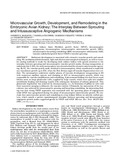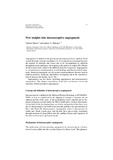| dc.contributor.author | Makanya, AN | |
| dc.contributor.author | Stauffer, Daniela | |
| dc.contributor.author | Ribatti, Domenico | |
| dc.contributor.author | Burri, Peter H | |
| dc.contributor.author | Djonov, Valentin G | |
| dc.date.accessioned | 2013-07-25T07:19:55Z | |
| dc.date.available | 2013-07-25T07:19:55Z | |
| dc.date.issued | 2005 | |
| dc.identifier.citation | Microscopy Research and Technique Volume 66, Issue 6, pages 275–288, 15 April 2005 | en |
| dc.identifier.uri | http://onlinelibrary.wiley.com/doi/10.1002/jemt.20169/full | |
| dc.identifier.uri | http://erepository.uonbi.ac.ke:8080/xmlui/handle/123456789/50930 | |
| dc.description.abstract | Embryonic development is associated with extensive vascular growth and remodeling. We used immunohistochemical, light and electron microscopical techniques, as well as vascular casting methods to study the developing chick embryo kidney with special attention to the interplay between sprouting and intussusceptive vascular growth modes. During inauguration at embryonic day 5 (E5), the early mesonephros was characterised by extensive microvascular sprouting. By E7, the vascular growth mode switched to intussusception, which contributed to rapid kidney vasculature growth up to E11, when the first obvious signs of vascular degeneration were evident. The metanephros underwent similar phases of vascular development inaugurating at E8 with numerous capillary sprouts and changing at E13 to intussusceptive growth, which was responsible for vascular amplification and remodeling. A phenomenal finding was that future renal lobules arose as large glomerular tufts, supplied by large vessels, which were split into smaller intralobular feeding and draining vessels with subsequent formation of solitary glomeruli. This glomerular duplication was achieved by intussusception, i.e., by formation of pillars in rows and their successive merging to delineate the vascular entities. Ultimately, the maturation of the vasculature was achieved by intussusceptive pruning and branching remodeling. An interesting finding was that strong VEGF expression was associated with the sprouting phase of angiogenesis while bFGF was upregulated during the phase of intussusceptive microvascular growth. We conclude that microvascular growth and remodeling in avian kidney follows an adroitly crafted pattern, which entails a precise spaciotemporal interplay between sprouting and intussusceptive angiogenic growth modes supported partly by VEGF and bFGF | en |
| dc.language.iso | en | en |
| dc.publisher | Wiley | en |
| dc.subject | Basic fibroblast growth factor (bFGF) | en |
| dc.subject | Intussusceptive angiogenesis | en |
| dc.subject | Intussusception | en |
| dc.subject | Intussusceptive microvascular growth (IMG) | en |
| dc.subject | Intussusceptive branching remodeling (IBR) | en |
| dc.subject | Intussusceptive arborization (IAR) | en |
| dc.subject | Vascular endothelial growth factor (VEGF) | en |
| dc.subject | Vascular sprouting | en |
| dc.title | Microvascular growth, development, and remodeling in the embryonic avian kidney: the interplay between sprouting and intussusceptive angiogenic mechanisms | en |
| dc.type | Article | en |
| local.publisher | Department of Veterinary Anatomy, University of Nairobi | en |
| local.publisher | Department of Human Anatomy and Histology, University of Bari Medical School, 70124 Bari, Italy | en |
| local.publisher | Institute of Anatomy, University of Berne, CH-3000 Berne 9, Switzerland | en |




